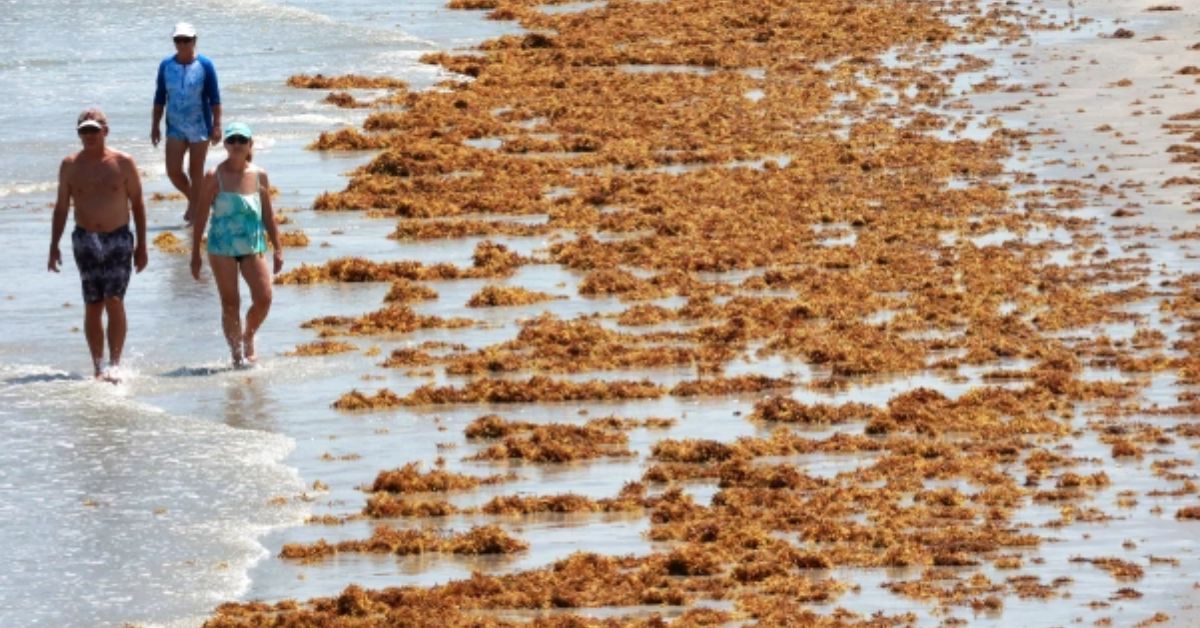An enormous seaweed bloom that originated in the Atlantic is moving towards Florida and other Gulf of Mexico coasts, where it could litter beaches with foul-smelling and potentially deadly piles and severely disrupt the region’s tourist industry.
In the Atlantic, a type of seaweed known as sargassum has been accumulating rapidly since 2011, and scientists have been monitoring the phenomenon ever since. More than five thousand nautical miles long, from the coast of Africa to the Gulf of Mexico, this year’s sargassum mass may be the longest ever recorded.
Dr. Brian Lapointe, a researcher at Florida Atlantic University’s Harbor Branch Oceanographic Center, predicts that the seaweed will become abundant on Florida beaches around July when the blob continues to move westward and enters the Caribbean and Gulf of Mexico this summer.
Throughout December and January, the sargassum bloom doubled in size, according to Lapointe. “was larger in January than it has ever been since this new region of sargassum growth began in 2011,” Lapointe told Rosemary Church.
“This is an entirely new oceanographic phenomenon that is creating such a problem — a catastrophic problem — for tourism in the Caribbean region where it piles up on beaches up to 5 or 6 feet deep,” Lapointe added.
He noted that in Barbados, locals were using “1,600 dump trucks a day to clean the beaches of this seaweed to make it suitable for tourists and recreation on the beaches.”
To read more news, click on the links given below:
- Florida Startup Shoots for the Moon With Data Center Plans!
- Florida Cold Has Caused Iguanas to Tumble Off Trees
What is Sargassum?
Even though the terms “sargassum” and “sargassum nations” are sometimes used interchangeably, the two most prevalent species of sargassum in the Atlantic are distinct.
The algae have their upsides when adrift at sea.
“This floating habitat provides food and protection for fishes, mammals, marine birds, crabs, and more,” according to the Sargassum Information Hub website, which is a joint project among various research institutions. “It serves as a critical habitat for threatened loggerhead sea turtles and as a nursery area for a variety of commercially important fishes such as mahi mahi, jacks, and amberjacks.”
The sargassum causes issues when it reaches the shores, where it can form impassable mounds and release a gas that has been likened to rotten eggs. In a short amount of time, it can go from helping to hurt marine life.

Large amounts of it “It comes in such large quantities that it sucks the oxygen out of the water and creates what we refer to as dead zones,” Lapointe explained.
According to Lapointe, sargassum is equally harmful to people. Hydrogen sulfide, the gas given off by decaying algae, is poisonous and can lead to breathing difficulties. “You have to be very careful when you clean the beaches,” he warned.
Arsenic can be found in the seaweed’s flesh, making it poisonous both when eaten and when used as fertilizer.
“If you are somewhere where you are harvesting this to use as fertilizer … you have to be very concerned, particularly if you are using it for a food and fiber crop for human consumption,” Lapointe told CNN on Thursday.
The millions of dollars required to clear up heaps of algae that have been placed on beaches are noted by the Sargassum Information Center.
Simply click on the following links to read other articles:
- Storm Subtropical Nicole Issues A Hurricane Warning For Florida East Coast
- Hurricane Ian Caused Flesh-eating Bacteria Infections in Florida
When and Why Sargassum Will Become a Concern in 2023?
According to oceanographer Dr. Gustavo Jorge Goni of NOAA’s Atlantic Oceanographic and Meteorological Laboratory, the growth of seaweed varies from year to year based on ecological factors, such as variations in nutrients, rainfall, and wind conditions, just like the growth of plants and crops on the land.
Goni also noted that ocean currents can affect the annual growth and accumulation of sargassum. The algae can also be fed by the phosphorus and nitrogen found in the ocean.
Lapointe took samples from the area where the sargassum originated and compared them to older samples from the 1980s; he found that the nitrogen level had increased by 45%. The exponential expansion of the bloom has led scientists to suspect an uptick in.
The EPA reports that rivers can dump phosphorus and nitrogen from human activities like farming and fossil fuel production into the ocean.
Researchers are currently investigating potential solutions to reduce its impact on beaches, such as sinking the seaweed to the ocean floor or harvesting it for use in commercial products like soap, according to Goni.
Goni warns that scientists’ current understanding of sargassum growth may change when more is learned about these accumulations.
“Whatever we believe we know today, it may change tomorrow,” he said.
